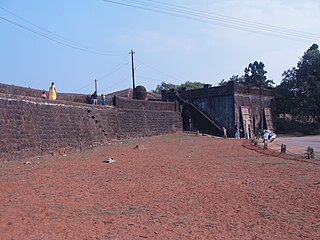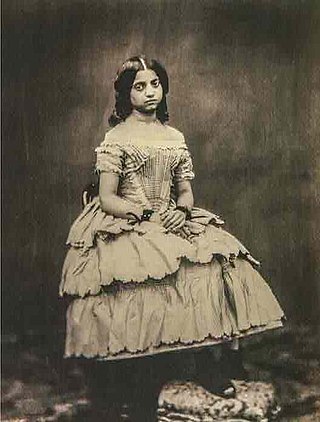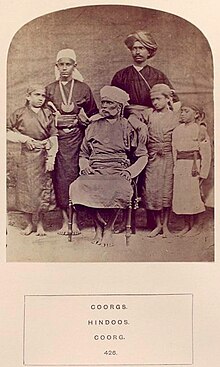
Kodagu district is an administrative district in the Karnataka state of India. Before 1956, it was an administratively separate Coorg State, at which point it was merged into an enlarged Mysore State.

Madikeri is a hill station town in Madikeri taluk and headquarters of Kodagu district in Karnataka, India.

The Kodava people or Kodavas are an ethno-linguistic group from the region of Kodagu in the southern Indian state of Karnataka, who natively speak the Kodava language. They are traditionally land-owning agriculturists and patrilineal, with martial customs. Kodavas worship ancestors and weapons. They used to worship swords, bows, arrows and later guns. Hence, Kodavas are the only ones in India permitted to carry firearms without a license.

The district of Kodagu in present-day Karnataka comprises the area of the former princely state of the same name.

Velayudhan Chempakaraman Thampi ofThalakulam (1765–1809) was the Dalawa or Prime Minister of the Indian kingdom of Travancore between 1802 and 1809 during the reign of Bala Rama Varma Kulasekhara Perumal. He is best known for being one of the earliest individuals to rebel against the British East India Company's authority in India.

The 106th Regiment of Foot was an infantry regiment of the British Army from 1862 to 1881, the third to bear the number after the Black Musqueteers (1761–1763) and a regiment raised briefly in 1794. It was formed by renaming the 2nd Bombay European Regiment, formed by the Honourable East India Company in 1839. In 1881 the 106th Regiment was joined with the 68th (Durham) Regiment of Foot to form the Durham Light Infantry, as its second regular battalion.

Madikeri Fort also called Mercara Fort is a fort in Madikeri, in the Kodagu district of the Indian state of Karnataka, first built by Mudduraja in the second half of the 17th century. Mudduraja also built the palace within the fort. It was rebuilt and restructured in granite by Tipu Sultan, and the site was then renamed Jaffarabad. Madikeri Fort is one of the many forts built or rebuilt by Tipu Sultan during his reign in the second half of the 18th century. In 1790, Dodda Vira Rajendra took control of the fort. The palace underwent renovations by Linga Rajendra II from 1812-1814. The British made additions to the fort in 1834. Notable structures in the fort include two stone statues of elephants at the northeast entry and a church in the southeast corner.
The Captivity of Kodavas (Coorgis) at Seringapatam was the period of capture, deportation, and imprisonment of Kodava Takk speaking Coorgis who rebelled against Tippu Sultan, the de facto ruler of the Kingdom of Mysore, they were caught during a number of attempts to suppress their rebellion in the 1780s.
The Travancore rebellion against the British East India Company was led by the prime ministers of the Indian states of Travancore and Cochin in 1808–09 with support from Sikhs ruling Punjab.

Dewan Bahadur Ketolira Chengappa, C.I.E., was born on 3 March 1878 to Ketolira Muddaiah & Bolliavva from Yavakapadi Village, Kabinakad, Napoklu. He completed his matriculation in the year 1893. Thereafter, he went on graduate from University of Madras. Later on he cleared the "Indian Civil Service" (ICS), officially known as the "Imperial Civil Service", is the elite higher civil service of the British Empire in British India during British rule. He joined the services as a parpathigar in 1909 and rose to become the Assistant Commissioner in 1916.

Coorg State was a Part-C state in India which existed from 1950 to 1956. When the Constitution of India came into force on 26 January 1950, most of the existing provinces were reconstituted into states. Thus, Coorg Province became Coorg State. Coorg State was ruled by a Chief Commissioner with Mercara as its capital. The head of the government was the Chief Minister. Coorg State was abolished on 1 November 1956 as per the States Reorganisation Act, 1956 and its territory were merged with Mysore State. Presently, Coorg forms a district of Karnataka state.

Coorg Province was a province of British India from 1834 to 1947 and the Dominion of India from 1947 to 1950. Mercara was the capital of the province. It was administered by a Commissioner and later, Chief Commissioner appointed by the Government of India. The Chief Commissioner, was usually based in Bangalore. From 1834 to 1881, the Chief Commissioner, was also the Commissioner of Mysore. From 1881 to 1940, the Chief Commissioner was usually the British Resident to the princely state of Mysore.

Victoria Gouramma was an Indian princess.

The Kingdom of Coorg was an independent kingdom that existed in India from the 16th century until 1834. It was ruled by a branch of the Ikkeri Nayaka. From 1780 to 1788, the kingdom was occupied by neighbouring Mysore but the Rajah of Coorg was restored by the British and became a protectorate of the British East India Company on 26 October 1790. In 1834, the then Raja of Coorg rebelled against British authority, sparking the Coorg War. The brief conflict led to the British to annex the kingdom in the same year, who transformed the region into a province of British India.

The St. Mark's Church, is located within the Mercara Fort, Coorg, India and was raised in 1859, by the officers and men of the East India Company. The church building was funded by the Government of Madras, and placed under the Church of England in India, Diocese of Madras. The Church was closed after Indian independence, and taken over by the Government of Karnataka in 1971. The building now houses the Madikeri Fort Museum, managed by the Karnataka State Archaeological Department.
The 1889 Birthday Honours were appointments by Queen Victoria to various orders and honours to reward and highlight good works by citizens of the British Empire. The appointments were made to celebrate the official birthday of The Queen, and were published in the London Gazette on 24 May 1889 and in The Times on 25 May 1889.
The 1891 Birthday Honours were appointments by Queen Victoria to various orders and honours to reward and highlight good works by citizens of the British Empire. The appointments were made to celebrate the official birthday of The Queen, and were published in the London Gazette on 29 May 1891 and in The Times on 30 May 1891.
Kalyatanda Ponnappa was a 17th-century warrior of Kodagu (Coorg). Since he was deified after his death, the people of Kodagu consider him to be a god. He is also known as Kaliat-Achchappa or Kaliat Ajjappa.

Mathanda Appachu was an Indian warrior and freedom fighter. He was an officer in Chikka Vira Rajendra's army. He was from Bollumad village in Beppunad in Kodagu. He was also known as Madanta Appachu.
Kannanda Doddayya was a Kodava commander who defeated Hyder Ali's forces thrice. He was also known as Kannana Doddayya and Doddanna.















